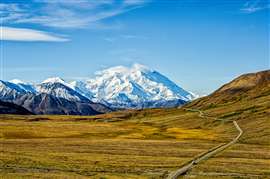Granite Construction awarded final leg of work in US National Park
16 February 2024
US-based company Granite recently completed preconstruction services for a project at the Alaska, US, Denali National Park, and the firm was awarded the final US$112 million construction option for the Polychrome Area Improvements Construction Manager/General Contractor (CM/GC) project.
 Tour Bus Driving Past Denali in Denali National Park, Alaska
Tour Bus Driving Past Denali in Denali National Park, Alaska
CM/GC projects are unlike tradition project delivery, where a design is completed before the owner selects the contractor.
Granite added that, “In a CM/GC project, the owner brings in the contractor towards the end of preliminary design phase. The contractor and designer then work together, under contractual coordination requirements, to complete the final design phase. In the process of working through the final design, they are able to work together to identify more opportunities for savings and flexibility.”
Granite’s role in the project includes:
- Construction of a 475-foot (145m) long, 50-foot (15m) tall, and 24-foot (7m) wide steel truss bridge to span the Pretty Rocks Landslide
- Excavation to the east and west of the bridge to accommodate construction activities and traffic; most of the excavated material will be added to the slope below the road.
- Slight realignment of the road on the west side of the bridge to allow for a proper turning radius for buses and other vehicles getting on and off the bridge
- Installation of 23 thermosyphons in the ground around the eastern abutment of the bridge to mitigate the potential for permafrost thaw and ensure the longevity of the bridge
- Installation of a retaining wall on the uphill side of the road to the east of the bridge, a soil nail wall below the road near the east abutment, and rock dowels below the road near the west abutment to stabilize the slopes
- Rock scaling, rock reinforcement, and/or creation of rockfall ditches to reduce rockfall risk
The US Federal Highway Administration (FHWA) was responsible for the bid and selection.
Funding for the bridge was secured through a combination of federal Bipartisan Infrastructure Law dollars, additional Federal Lands Transportation Fund dollars, and 2023 Disaster Relief Supplement funding.
To date, Granite has been contracted for roughly US$270 million-worth of work on the endeavour.
Pretty Rocks landslide a slow natural disruption
The Pretty Rocks landslide led to the job’s necessity, but it was not a singular destructive event (such as a natural disaster) as much as a slow natural disruption.
“The Pretty Rocks landslide has been active since at least the 1960s,” explains NPS, adding “and probably since well before the Denali Park Road was built through this area in 1930.”
Decades of general maintenance sufficed until 2014. “Before 2014, the landslide only caused small cracks in the road surface and required moderate maintenance every two to three years,” says NPS. However, from 2014 the speed of the landslide increased, leading to major road displacement.
The parks agency says the landslide is near the midpoint of Denali Park Road (which the public uses to traverse the 24,464 km2 conservancy). At present, roughly 90m of road has been displaced as the natural event “evolved from a minor maintenance concern to one that has caused substantial road restrictions.”
 The timetable for the Denali National Park Pretty Rocks landslide project. (Image: National Parks Service)
The timetable for the Denali National Park Pretty Rocks landslide project. (Image: National Parks Service)
‘You shall not pass’ – when will the road reopen?
According to Granite, construction of the Polychrome Area Improvements project began in 2023 with mobilisation, development of a worker camp, pioneering access across the landslide, blasting, and mass earthwork.
Work planned for the 2024 season includes completion of mass earthwork, construction of the bridge abutments, installation of a temporary launching system, and partial erection of the structural steel bridge.
Bridge erection will continue through 2025, along with launching of the structure to span the landslide.
For the 2026 season, construction includes setting precast bridge approaches, building a retaining wall, installing thermosyphon condensers, coating the bridge deck, and demobilization. According to the company, “thermosyphons are part of a passive heat exchange system designed to prevent permafrost from thawing and creating instability.”
STAY CONNECTED



Receive the information you need when you need it through our world-leading magazines, newsletters and daily briefings.
CONNECT WITH THE TEAM








